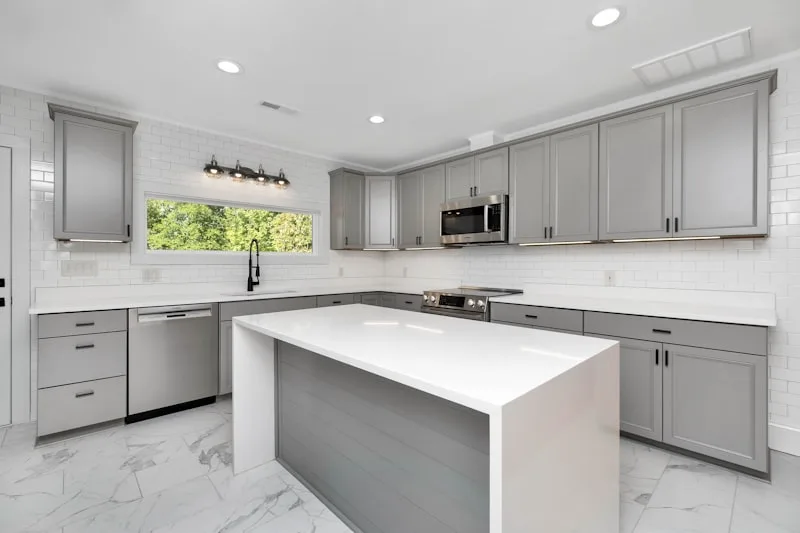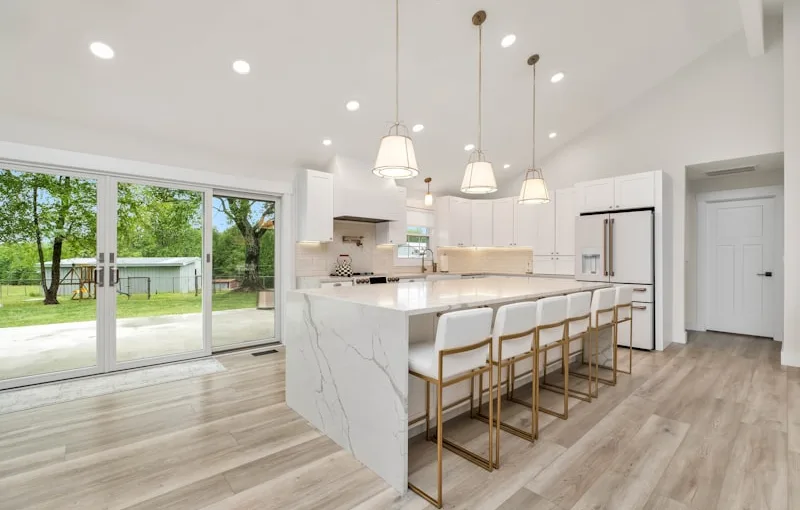First things first, gather your tools. You’ll need a miter saw, a nail gun or hammer, wood glue, and a measuring tape. Think of these tools as your trusty sidekicks on this DIY adventure. Now, measure the top of your cabinets carefully. You want to ensure that your crown molding fits perfectly, just like a well-tailored suit.
Next, it’s time to cut the molding. This is where the miter saw comes into play. You’ll want to make 45-degree cuts at the ends of your molding pieces. Picture this: you’re creating a beautiful frame for your cabinets, and those angles are crucial for a seamless fit.
Once you’ve got your pieces cut, it’s time to attach them. Start by applying a bit of wood glue to the back of the molding. This is like giving your molding a warm hug before it meets the cabinets. Then, position the molding on top of the cabinets and secure it with your nail gun or hammer. If you’re using a hammer, be gentle—think of it as a delicate dance rather than a heavy stomp.
Don’t forget to fill in any nail holes with wood filler for a polished finish. Sand it down once it’s dry, and you’ll have a smooth surface that’s ready for paint or stain. Just like that, your kitchen cabinets have transformed into a stunning focal point! So, roll up your sleeves and get ready to elevate your kitchen’s style with crown molding.
Elevate Your Kitchen: A Step-by-Step Guide to Attaching Crown Molding to Cabinets
First things first, gather your materials. You’ll need crown molding, a miter saw, a nail gun (or hammer and finishing nails), wood glue, and a level. Think of these tools as your trusty sidekicks on this home improvement adventure. Once you have everything, measure the top of your cabinets. This is where the magic happens, so precision is key!
Next, cut your crown molding at a 45-degree angle. If you’re feeling a bit intimidated, don’t worry! It’s just like cutting a pizza—just aim for those perfect slices. Once you’ve got your pieces cut, it’s time to attach them. Start with the corners, using wood glue to secure them in place. Then, nail them down. It’s like giving your cabinets a stylish hat that fits just right!
Now, here’s a pro tip: use a level to ensure everything is straight. There’s nothing worse than a lopsided crown! Once you’ve nailed everything down, fill in any gaps or nail holes with wood filler. This step is like putting on a fresh coat of paint—it makes everything look polished and complete.
Finally, stand back and admire your handiwork. You’ve just transformed your kitchen into a space that feels more luxurious and inviting. Who knew a little molding could make such a big difference? So, roll up your sleeves and get started—your dream kitchen is just a few steps away!
Crown Molding Magic: Transform Your Kitchen Cabinets with These Expert Tips
First off, think of crown molding as the cherry on top of your kitchen sundae. It adds that finishing touch that ties everything together. When choosing your molding, consider the style of your kitchen. Are you going for a modern vibe or something more traditional? The right crown molding can complement your cabinets beautifully, enhancing their design rather than overshadowing it.
Now, let’s talk installation. If you’re feeling adventurous, you might want to tackle this project yourself. It’s like a puzzle—measure twice, cut once! But if DIY isn’t your thing, don’t hesitate to call in the pros. A well-installed crown molding can make your cabinets look custom-made, and who doesn’t love that?
Color is another game-changer. Painting your crown molding the same color as your cabinets can create a seamless look, while a contrasting color can add a pop of personality. Think of it as accessorizing an outfit; the right color can make all the difference.
Lastly, don’t forget about lighting! Installing under-cabinet lighting can highlight your new crown molding, creating a warm and inviting atmosphere. It’s like adding a spotlight to your kitchen’s best features.
So, are you ready to sprinkle some crown molding magic into your kitchen? With these tips, you’ll be well on your way to transforming your cabinets into a stunning focal point that will impress everyone who walks through your door.
DIY Delight: How to Perfectly Attach Crown Molding to Your Kitchen Cabinets
First things first, gather your materials. You’ll need crown molding, a miter saw, wood glue, finishing nails, and a nail gun if you have one. Think of the crown molding as the cherry on top of your kitchen sundae—it’s the finishing touch that ties everything together. Now, measure the top of your cabinets carefully. Precision is key here; you don’t want to end up with a jigsaw puzzle of mismatched pieces!
Once you’ve got your measurements, it’s time to cut the molding. Set your miter saw to a 45-degree angle for those corners. It’s like cutting a slice of cake—get it right, and it’ll look delicious! After cutting, dry-fit the pieces to ensure they fit snugly. If they don’t, don’t panic! A little sanding can work wonders.
Now, let’s get to the fun part—attaching the molding. Apply wood glue to the back of the molding and press it against the cabinet. Use your nail gun to secure it in place, or hammer in those finishing nails if you’re feeling old-school. It’s like giving your cabinets a stylish hat; they’ll thank you for it!
Finally, fill in any gaps with caulk and paint or stain to match your cabinets. Voilà! You’ve just transformed your kitchen into a space that radiates charm and sophistication. So, roll up your sleeves and get ready to impress your friends with your DIY skills!
From Ordinary to Extraordinary: The Art of Crown Molding on Kitchen Cabinets
Crown molding is that elegant trim that sits atop your cabinets, giving them a polished, sophisticated look. It’s like the cherry on top of a sundae—without it, your kitchen might feel a bit flat. Think about it: when you add that decorative touch, it transforms your ordinary cabinets into a stunning focal point. It’s not just about aesthetics; it’s about creating a cohesive design that ties the whole room together.

Now, you might be wondering, “Is it really that easy to install?” Well, yes and no! While it can be a DIY project for the adventurous, getting that perfect fit can be a bit tricky. But don’t let that scare you off! With a little patience and the right tools, you can elevate your kitchen from drab to fab.
And let’s talk about styles! Whether you’re into classic, modern, or something in between, there’s a crown molding style that can complement your cabinets beautifully. It’s like choosing the right outfit for a special occasion—pick the one that makes you feel amazing!

So, if you’re looking to add a touch of elegance to your kitchen, consider crown molding. It’s a small detail that can make a world of difference, turning your space into a culinary masterpiece that you’ll love showing off to friends and family.
Frequently Asked Questions
What Type of Crown Molding is Best for Kitchen Cabinets?
When selecting crown molding for kitchen cabinets, consider materials like wood or medium-density fiberboard (MDF) for durability and aesthetics. Opt for styles that complement your kitchen’s design, such as traditional, modern, or farmhouse. The best choice balances visual appeal with functionality, ensuring it enhances the overall look while being easy to maintain.
What Tools Do I Need to Attach Crown Molding to Kitchen Cabinets?
To attach crown molding to kitchen cabinets, you will need a miter saw for precise angle cuts, a nail gun or hammer and finishing nails for secure attachment, wood glue for added strength, a measuring tape for accurate lengths, and a level to ensure proper alignment. Additionally, having a stud finder can help locate support for heavier pieces.
How Do I Cut Crown Molding for a Perfect Fit?
To achieve a perfect fit when cutting crown molding, start by measuring the wall angles accurately, typically 45 degrees for corners. Use a miter saw set to the correct angle for both the left and right pieces. Make precise cuts, ensuring the molding is positioned upside down against the saw for accurate beveling. Test the fit by dry-fitting the pieces before final installation, making adjustments as necessary for a seamless look.
How Do I Measure for Crown Molding on Cabinets?
To measure for crown molding on cabinets, start by determining the height and depth of the cabinets. Use a tape measure to find the width of each cabinet section where the molding will be installed. Record these measurements, ensuring to account for any angles or corners. For angled ceilings, measure the slope to ensure a proper fit. Finally, add a few extra inches to each measurement for adjustments during installation.
What is the Best Method to Secure Crown Molding to Cabinets?
To securely attach crown molding to cabinets, use a combination of adhesive and finishing nails. Start by applying a strong construction adhesive to the back of the molding for a solid bond. Then, position the molding at the desired angle and use finishing nails to fasten it to the cabinet. Ensure the nails are evenly spaced for stability. For a clean finish, fill any nail holes with wood filler and sand smooth before painting or staining.
